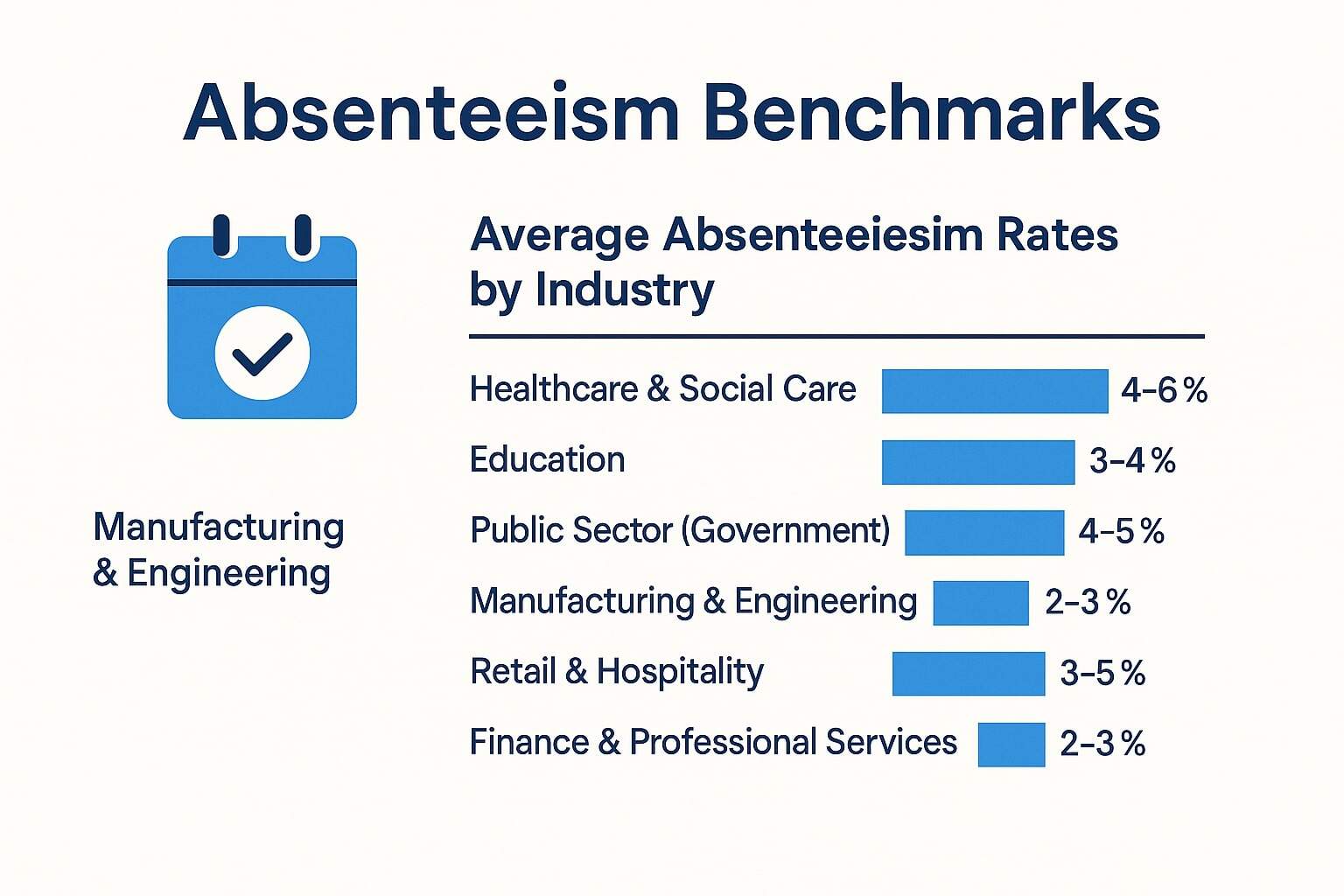Manage Absence – Employing Metrics And Action Triggers

Absence has tremendous impact to smaller businesses and it becomes crucial to manage absence effectively. According to the Federation of Small Businesses, small companies are the massive sufferers from employees taking periods of short-term absence. It is reported that long-term absence can hold an expensive corner, creating huge problems.
In 2020, a new study by Westfield health proclaimed that absenteeism cost UK businesses £14 billion
The preliminary report is that small businesses are less likely to observe sickness absence and proactively manage it. This probably happens due to competing priorities or a shortage of proper knowledge in dealing with similar situations, specifically when the business owner knows the employee well. Leveraging data can help small businesses identify absence trends and make informed decisions to address these challenges.
To effectively observe and manage absence, it is important to track employee attendance and understand patterns over time. Software solutions can assist in tracking absence and analyzing data to spot trends, enabling more proactive and data-driven absence management.
Why Estimating Absence Is A Good Idea?
The Chartered Institute of Personnel & Development instructs that all companies ought to record the employee absence. The staff needs to complete a self-certificate for the sick leave for less than a week and must submit a doctor’s fit note for longer absences time. These documents are later required for Statutory Sick Pay purposes.
Why is this essential? Absolutely, it’s not easy to recall that “employee X” was on sick leave for a couple of weeks ago and is now off sick again. It’s not obvious that “employee Y” manages to be off sick after holidays or on an occasional day. So, that’s where tracking the leave helps you decide and manage the cases. Tracking individual instances of absence helps you identify frequent absences and patterns, making it easier to spot recurring issues and take appropriate action.
There are numeral ways of calculating absence like the frequency rate, the lost time rate, the individual frequency rate and the Bradford factor. For an easy working pattern, choose only one way of calculating sickness and stick to it. For example, using the frequency rate can help you monitor how many instances of absence occur within a set period, while the Bradford factor highlights frequent short-term absences. “The lost time rate” method is the most used option by companies that informs you the working time in percentage been lost to absence during a certain period of time.
Tips to Decline & Manage Absence
The outlay of sickness absence in 2019 stood at a median of £568 and an average of £544 per employee.
Understanding the driving aspects behind employee absenteeism and the solution to prevent it can aid employers to reduce the costs. Identifying the root issue and addressing concerns early can lead to more effective absence management outcomes. Check out these 5 ways to help reduce cost!
- Trail employee absence
- Alter employee behaviour
- Help employees return to work, and refer employees to appropriate support services if concerns or issues arise
- Relieve office stress
- Propose an excellent paid-time-off policy
Avoiding Discrimination in Absence Management
Avoiding discrimination is a fundamental part of any effective absence management process. Employers must ensure that all employees are treated fairly and consistently, regardless of the reasons behind their absence. This is especially important when dealing with long term sickness or repeated absence, where individual circumstances such as disability or ongoing health conditions may be involved.
To manage absence without discrimination, employers should use trigger points as an opportunity to review and support employees, rather than as an automatic step towards disciplinary action. Each case of employee absence should be considered on its own merits, with reasonable adjustments made where necessary to support those with disabilities or health issues. This might include changes to working hours, duties, or providing additional support to help the employee return to work.
A fair absence management process should be transparent, with clear guidelines that are applied consistently across the organisation. Employers should regularly review their absence policies and ensure that managers are trained to recognise and avoid bias. By focusing on support and making reasonable adjustments, employers can reduce the risk of discrimination claims and foster a more inclusive and positive workplace environment.
Role of Line Managers in Absence Management
Line managers are central to the success of any absence management process. As the first point of contact for employees who are absent due to illness, line managers are in a unique position to identify absence related issues early and provide additional support where needed. Their role includes monitoring employee absence, facilitating return to work discussions, and ensuring that employees understand the expectations and procedures around sick leave.
Effective line managers are trained to manage absence fairly and consistently, taking into account individual circumstances and the specific needs of each employee. They should be proactive in offering support to employees who are struggling, whether that means signposting to occupational health, arranging flexible working, or simply maintaining regular communication during periods of absence.
By empowering line managers to take an active role in managing absence, employers can help to reduce the impact of absence on the workplace, improve employee wellbeing, and ensure that the absence management process is followed correctly. This approach not only supports employees but also helps organisations to address issues before they escalate, leading to better outcomes for both staff and the business.
Executing Trigger Points To Handle Managing Absence
Establish an absence monitor
The foremost initiative would be to enhance an automatic return to work call after any sick leave, whether it was for a day. Doing so should be titled as the very first step in a leave management system, where a follow-up is taken asking about their absence period and health. This process will indicate your care and also the updates being recorded.
Employing the absence stages
Adopting these triggers will minister employees consistently and follow the correct approach in different systems. For example, an employee who has a poor record of short-term absences and has no underlying health condition can be alerted that failing to improve their attendance will impact in disciplinary action.
However, you can politely manage an employee with a problematic health situation by meeting with them and getting medical information from their doctors. The latter case aims to find ways to keep the employee’s return to work. Still, if this proves to be impossible, you will have the evidence you need to operate the capability process and overlook the employee for reasons of ill health.
Make the employees understand
Ensure following both the methodologies implies results:
- Introductory Communication
- Personal Communication
Introductory Communication needs a description of the new absence stage where you communicate to the employees about the absence stage and appreciate their essence in the company.
Your message should emphasise the supportive side and intend to focus on employees’ healthiness and well wishes of employees. Nevertheless, you must also get the message across that good attendance is vital to the business’s success.
Personal Communication needs a description of a similar message on the individual note compressing the details and implementation more politely. This enables a more personal relationship with the employees emphasising the fairness and consistency of the absence management process. This communication will make this system work easy, even in difficult situations.
Addressing Long Term Sickness
Managing long term sickness requires a thoughtful and supportive approach, as employees may be dealing with serious health issues or disabilities. Employers should have a clear absence management process in place that includes regular review meetings and ongoing communication with the absent employee. Trigger points can help identify when an employee is at risk of long term sickness, prompting early intervention and support.
It is important for employers to consider making reasonable adjustments to help employees who are struggling with long term sickness. This could involve modifying duties, adjusting working hours, or providing additional resources to support their return to work. Employers should also be aware of the potential consequences of long term sickness, such as the impact on the employee’s role, the possibility of redeployment, or, in some cases, ill health retirement.
Throughout the process, individual circumstances must be taken into account, and advice should be sought from HR or occupational health professionals when necessary. Clear communication and a supportive attitude are essential to ensure that employees feel valued and understood. By managing long term sickness proactively and compassionately, employers can help reduce the duration of absence, support employee recovery, and ensure that all procedures are followed correctly.
Wrap-up
Embracing these triggers and targets has been demonstrated to reduce absence levels overall. But Just reducing the absence rate isn’t overall impactful; hunting the absence rate is more essential. So, to track the leave and absence of your employees, look no further than ScheduleLeave.
A smarter, easier and digital-rich solution to effectively track employee leave & absence rates.



